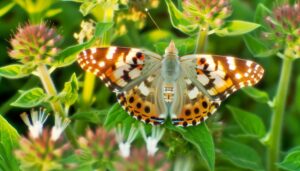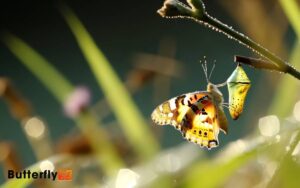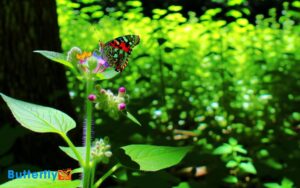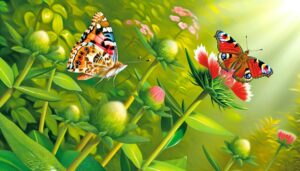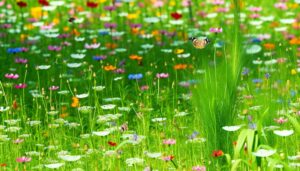New Mexico Painted Lady Butterfly: Explore Their Presence!
The New Mexico Painted Lady Butterfly exhibits a striking orange and black wing pattern with white spots and distinctive blue eyespots on its hindwings.
It thrives in arid and semi-arid regions, ranging from desert basins to plateaus, and prefers temperatures between 68-86°F.
These butterflies migrate northward in spring and southward in autumn, covering significant distances. They play vital ecological roles in pollination and serve as an indicator species for habitat health.
Conservation efforts focus on preserving native plants and creating butterfly corridors. For a deeper understanding of their life cycle and ecological importance, continue exploring.

Key Takeaways
Identification and Appearance
Typically, the New Mexico Painted Lady Butterfly can be identified by its distinctive orange and black wing pattern with white spots.
The forewings display a complex arrangement of black patches and white dots, while the hindwings feature a series of blue eyespots near the margins.
The undersides of the wings reveal a more subdued palette, showcasing intricate brown and gray patterns that provide effective camouflage against predators.
Measuring approximately 5-9 centimeters in wingspan, this butterfly exhibits sexual dimorphism, with females generally being larger than males. The antennae are clubbed, aiding in navigation and sensory perception.
Observers often note the rapid, erratic flight pattern, which is characteristic of the species. This remarkable appearance makes it easily distinguishable from other butterflies.
Habitat and Distribution
The New Mexico Painted Lady Butterfly thrives in arid and semi-arid climates, preferring temperatures between 70-85°F. Its geographic range spans from North America to Central America, adapting to various elevations and ecosystems.
During seasonal migration, it exhibits predictable north-south movement patterns, often influenced by changing weather conditions.
Preferred Climate Conditions
In addition, New Mexico Painted Lady butterflies thrive in arid and semi-arid climates, favoring regions with abundant sunlight and sparse vegetation. These conditions support their thermoregulation and foraging behaviors.
They seek out areas with low humidity and moderate temperatures, typically between 20-30°C (68-86°F).
Their preferred habitats include deserts, grasslands, and scrublands, where they can find host plants like thistles and mallows. The sparse vegetation allows for easier navigation while searching for nectar sources.
Moreover, these butterflies exhibit a preference for open landscapes, which facilitate their migratory patterns.
Seasonal variations in temperature and precipitation influence their activity levels and reproductive cycles, often leading to periods of increased visibility and movement during warmer months.
Geographic Range Overview
Inhabiting regions that provide the arid, sunlit conditions they favor, Painted Lady butterflies in New Mexico are primarily found across deserts, grasslands, and scrublands.
These habitats offer the open, warm environments essential for their survival. They prefer areas with abundant host plants such as thistles and mallows, which are necessary for larval development.
Elevations ranging from lowland desert basins to higher plateau regions support their populations. Observations indicate these butterflies are particularly active in locales with plentiful nectar sources, including wildflowers like asters and sunflowers.
Their adaptability allows them to thrive in diverse locations, from the Chihuahuan Desert to the edges of the Colorado Plateau, making them a common sight in New Mexico’s varied landscapes.
Seasonal Migration Patterns
Curiously, Painted Lady butterflies in New Mexico undertake seasonal migrations that are dictated by temperature fluctuations and availability of food resources.
These butterflies travel northward during the spring when temperatures rise and vegetation flourishes. They depend on nectar from flowering plants and host plants like thistles for laying eggs.
As autumn approaches and temperatures drop, they migrate southward to warmer regions. This migratory behavior guarantees their survival through seasonal changes. Observations indicate that they can cover distances up to 100 miles a day with favorable winds.
Their migration isn’t a single generation journey; rather, it involves multiple generations, each one advancing the migration. This adaptability highlights their resilience and intricate relationship with the environment.
Life Cycle Stages
The New Mexico Painted Lady butterfly undergoes a complete metamorphosis encompassing four distinct stages: egg, larva (caterpillar), pupa (chrysalis), and adult butterfly.
Females lay eggs on host plants, which hatch into caterpillars that feed voraciously on the foliage.
After reaching full size, the caterpillar forms a chrysalis, from which the adult butterfly eventually emerges, completing the transformation.
Egg to Caterpillar
Upon laying, the tiny, pale green eggs of the New Mexico Painted Lady Butterfly adhere to the underside of host plant leaves, marking the beginning of their life cycle. These eggs, about 0.5 mm in diameter, hatch within 3 to 5 days.
Emerging larvae, or caterpillars, measure approximately 2 mm and initially exhibit a dark, spiny appearance. They consume the eggshell first for nourishment before feeding on the host plant.
Over the next two weeks, caterpillars undergo five instars, growing up to 25 mm. They display distinct banding patterns of black, yellow, and white. During this stage, they’re voracious feeders, preparing for the next transformation.
Understanding these early stages is crucial for comprehending the butterfly’s developmental process.
Chrysalis to Butterfly
Once the caterpillar reaches full size, it seeks a suitable spot to pupate, attaching itself securely before shedding its final larval skin to reveal the chrysalis.
Inside the chrysalis, the metamorphosis process begins. Enzymes break down the caterpillar’s tissues, and imaginal discs, previously dormant, develop into adult structures like wings, legs, and antennae.
This stage lasts about 7-10 days, during which the butterfly’s form becomes increasingly evident.
As the transformation completes, the chrysalis darkens. The adult butterfly then emerges, a process known as eclosion. It pumps hemolymph into its wings to expand them, waiting several hours for them to harden and dry.
Once ready, the New Mexico Painted Lady takes flight, beginning its life as a pollinator.
Diet and Feeding Habits
Feeding primarily on nectar, the New Mexico Painted Lady Butterfly exhibits a preference for flowers such as thistles, asters, and sunflowers. This species demonstrates a definitive pattern in its feeding habits, which are essential for its survival and reproduction.
Observations highlight that they:
- Select flowers with high nectar content.
- Utilize their proboscis to extract nectar efficiently.
- Prefer brightly colored blooms, which are often more visible.
- Exhibit a tendency to feed during daylight hours, optimizing visibility and energy intake.
These butterflies play an important role in pollination, contributing to the ecosystem’s overall health. Their selective feeding behavior ensures that they obtain the necessary nutrients for growth and sustenance, while also supporting the reproductive cycles of various flowering plants.
Migratory Patterns
The New Mexico Painted Lady Butterfly frequently undertakes long-distance journeys, driven by seasonal changes and the pursuit of ideal breeding conditions. These butterflies often travel thousands of miles, moving with remarkable precision.
They typically migrate northward in spring and southward in autumn, responding to temperature shifts and resource availability.
During migration, they rely on environmental cues such as wind currents and the position of the sun. Researchers have observed that their migratory patterns are influenced by climatic factors and habitat disruptions.
The following table summarizes key aspects of their migration:
| Parameter | Spring Migration | Autumn Migration |
|---|---|---|
| Direction | Northward | Southward |
| Trigger | Temperature rise | Temperature drop |
| Distance | Thousands of miles | Thousands of miles |
| Key Cues | Sun position | Wind currents |
| Influencing Factors | Climate change | Habitat loss |
These movements support the survival and reproduction of the species.
Ecological Role
New Mexico Painted Lady Butterflies play an essential role in pollination, aiding the reproduction of various plant species across their migratory routes.
Their migratory behavior secures the genetic diversity of flora, contributing greatly to ecosystem stability. Observations reveal that they prefer nectar from composite flowers, facilitating cross-pollination.
Their ecological role includes:
- Pollination: Enhancing genetic diversity in plants.
- Prey: Serving as a food source for birds, spiders, and other predators.
- Herbivory: Larvae feed on host plants, influencing plant population dynamics.
- Indicator Species: Reflecting the health of their habitats, signaling changes in environmental conditions.
These butterflies thrive in diverse habitats, from deserts to urban gardens, demonstrating their adaptability and ecological significance.
Conservation Efforts
Recognizing the critical role of New Mexico Painted Lady Butterflies in ecosystems, conservationists have initiated targeted efforts to safeguard their habitats and maintain their populations stable.
They’re restoring native plant species essential for the butterflies’ lifecycle, such as thistles and mallows, to guarantee ample food sources.
Additionally, they’re establishing butterfly corridors to connect fragmented habitats, facilitating migration and genetic diversity.
Monitoring programs track population dynamics and health, employing citizen science to gather detailed data.
Conservationists also advocate for reduced pesticide use, which directly impacts butterfly survival.
Conclusion
To guarantee the New Mexico Painted Lady butterfly, with its vibrant hues and intricate patterns, is a marvel of nature’s artistry. This delicate creature flutters gracefully among wildflowers, showcasing a mesmerizing dance of color in the sunlight. Like a lady painted like a butterfly, its wings tell a story of beauty, transformation, and resilience in the natural world.
It thrives in diverse habitats, undertakes remarkable migrations, and plays a critical role in pollination.
Each life stage, from egg to adult, is a proof of its resilience and adaptability.
Conservation efforts are crucial to make sure this delicate dancer of the skies continues to grace our ecosystems, highlighting the intricate balance of our natural world.


